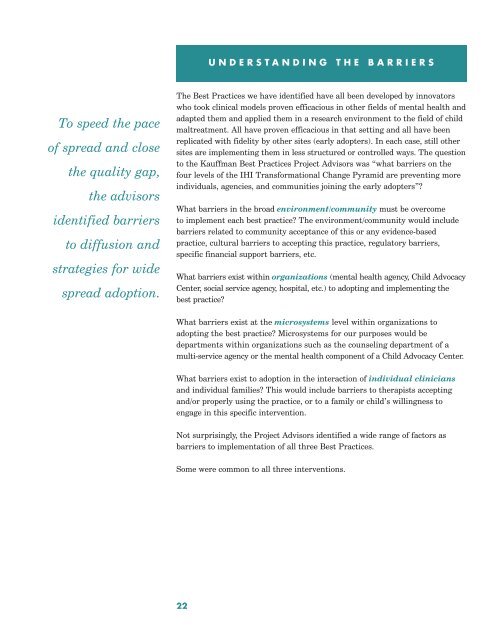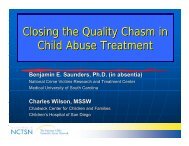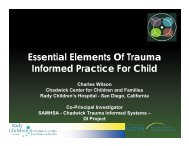Kauffman Best Practices Project Final Report - The Chadwick Center ...
Kauffman Best Practices Project Final Report - The Chadwick Center ...
Kauffman Best Practices Project Final Report - The Chadwick Center ...
Create successful ePaper yourself
Turn your PDF publications into a flip-book with our unique Google optimized e-Paper software.
UNDERSTANDING THE BARRIERS<br />
To speed the pace<br />
of spread and close<br />
the quality gap,<br />
the advisors<br />
identified barriers<br />
to diffusion and<br />
strategies for wide<br />
spread adoption.<br />
<strong>The</strong> <strong>Best</strong> <strong>Practices</strong> we have identified have all been developed by innovators<br />
who took clinical models proven efficacious in other fields of mental health and<br />
adapted them and applied them in a research environment to the field of child<br />
maltreatment. All have proven efficacious in that setting and all have been<br />
replicated with fidelity by other sites (early adopters). In each case, still other<br />
sites are implementing them in less structured or controlled ways. <strong>The</strong> question<br />
to the <strong>Kauffman</strong> <strong>Best</strong> <strong>Practices</strong> <strong>Project</strong> Advisors was “what barriers on the<br />
four levels of the IHI Transformational Change Pyramid are preventing more<br />
individuals, agencies, and communities joining the early adopters”?<br />
What barriers in the broad environment/community must be overcome<br />
to implement each best practice? <strong>The</strong> environment/community would include<br />
barriers related to community acceptance of this or any evidence-based<br />
practice, cultural barriers to accepting this practice, regulatory barriers,<br />
specific financial support barriers, etc.<br />
What barriers exist within organizations (mental health agency, Child Advocacy<br />
<strong>Center</strong>, social service agency, hospital, etc.) to adopting and implementing the<br />
best practice?<br />
What barriers exist at the microsystems level within organizations to<br />
adopting the best practice? Microsystems for our purposes would be<br />
departments within organizations such as the counseling department of a<br />
multi-service agency or the mental health component of a Child Advocacy <strong>Center</strong>.<br />
What barriers exist to adoption in the interaction of individual clinicians<br />
and individual families? This would include barriers to therapists accepting<br />
and/or properly using the practice, or to a family or child’s willingness to<br />
engage in this specific intervention.<br />
Not surprisingly, the <strong>Project</strong> Advisors identified a wide range of factors as<br />
barriers to implementation of all three <strong>Best</strong> <strong>Practices</strong>.<br />
Some were common to all three interventions.<br />
22






